ESP YAMAHA VX DELUXE 2013 Owners Manual
[x] Cancel search | Manufacturer: YAMAHA, Model Year: 2013, Model line: VX DELUXE, Model: YAMAHA VX DELUXE 2013Pages: 96, PDF Size: 3.9 MB
Page 3 of 96
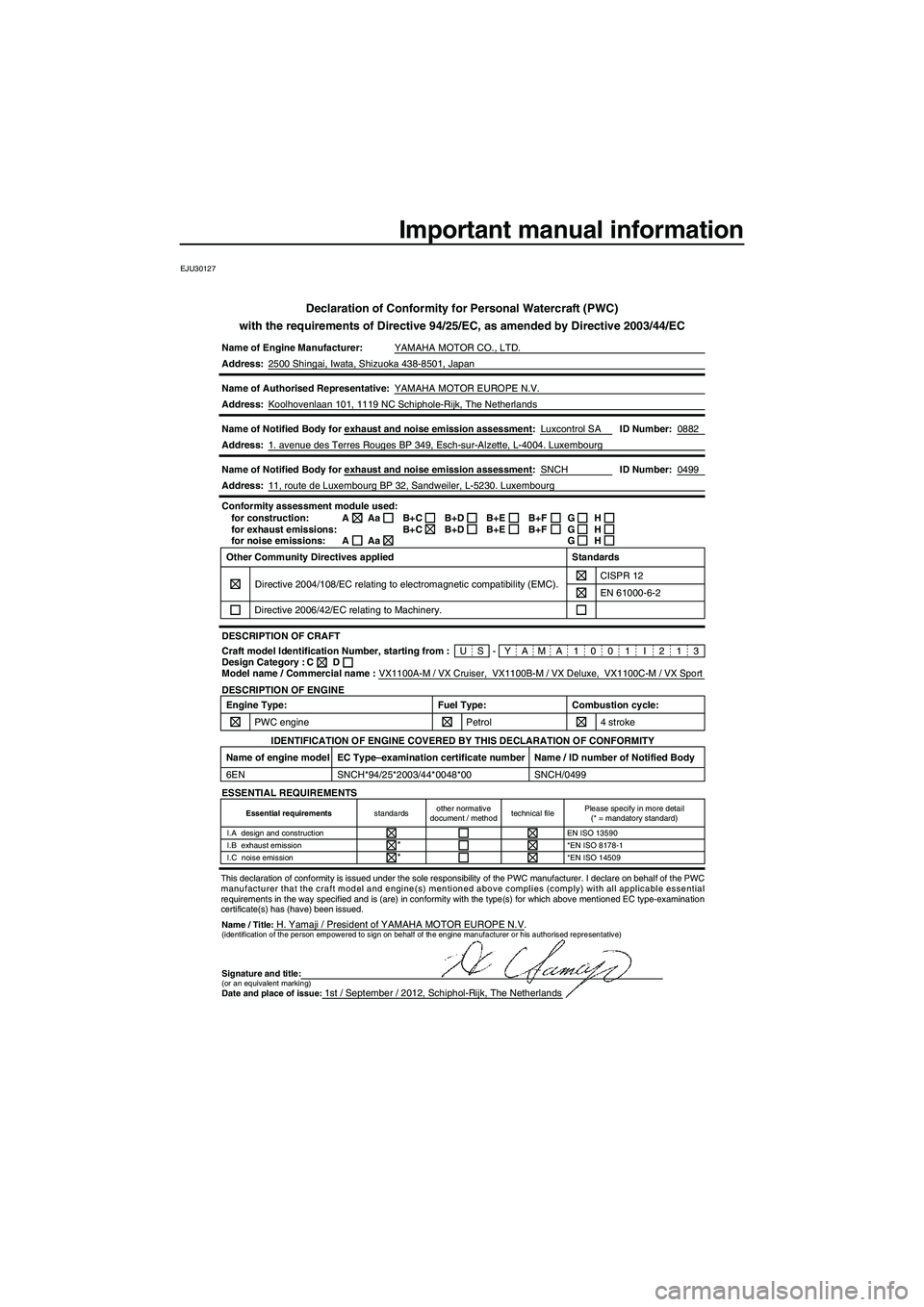
Important manual information
EJU30127
Declaration of Conformity for Personal Watercraft (PWC)
with the requirements of Directive 94/25/EC, as amended by Directive 200\
3/44/EC
Name of Engine Manufacturer: YAMAHA MOTOR CO., LTD.
Name / Title:H. Yamaji / President of YAMAHA MOTOR EUROPE N.V.
Address:
2500 Shingai, Iwata, Shizuoka 438-8501, Japan
Name of Authorised Representative: YAMAHA MOTOR EUROPE N.V.
Address: Koolhovenlaan 101, 1119 NC Schiphole-Rijk, The Netherlands
Name of Notified Body for exhaust and noise emission assessment: Luxcontrol SA
Address: 1. avenue des Terres Rouges BP 349, Esch-sur-Alzette, L-4004. Luxembourg\
Name of Notified Body for exhaust and noise emission assessment: SNCH
VX1100A-M / VX Cruiser, VX1100B-M / VX Deluxe, VX1100C-M / VX Sport
0882
0499
ID Number:
ID Number:
Address: 11, route de Luxembourg BP 32, Sandweiler, L-5230. Luxembourg
US-YAMA1001 I 213
Conformity assessment module used:
for construction:
for exhaust emissions:
for noise emissions:
DESCRIPTION OF CRAFT
DESCRIPTION OF ENGINE A
A
Craft model Identification Number, starting from :
Model name / Commercial name : C
Design Category : Other Community Directives applied
Directive 2004/108/EC relating to electromagnetic compatibility (EMC).\
CISPR 12
Directive 2006/42/EC relating to Machinery. Standards
EN 61000-6-2
D
Aa
AaB+C
B+CB+D
B+D B+E
B+EB+F
B+FG
G
GH
H
H
Engine Type:
PWC engine Combustion cycle:
4 stroke
Fuel Type:
Petrol
ESSENTIAL REQUIREMENTS
IDENTIFICATION OF ENGINE COVERED BY THIS DECLARATION OF CONFORMITY
Name of engine model
6EN Name / ID number of Notified Body
SNCH/0499
EC Type–examination certificate number
SNCH*94/25*2003/44*0048*00
(identification of the person empowered to sign on behalf of the engine\
manufacturer or his authorised representative)
Signature and title:(or an equivalent marking)Date and place of issue:1st / September / 2012, Schiphol-Rijk, The Netherlands
Essential requirements
standardsother normative
document / method technical filePlease specify in more detail
(* = mandatory standard)
I.A design and construction EN ISO 13590
I.B exhaust emission *EN ISO 8178-1
I.C noise emission *EN ISO 14509
*
*
This declaration of conformity is issued under the sole responsibility o\
f the PWC manufacturer. I declare on behalf of the PWC
manufacturer that the craft model and engine(s) mentioned above compli\
es (comply) with all applicable essential
requirements in the way specified and is (are) in conformity with the \
type(s) for which above mentioned EC type-examination
certificate(s) has (have) been issued.
ID Number:
ID Number:
UF2P70E0.book Page 1 Tuesday, July 31, 2012 1:48 PM
Page 5 of 96
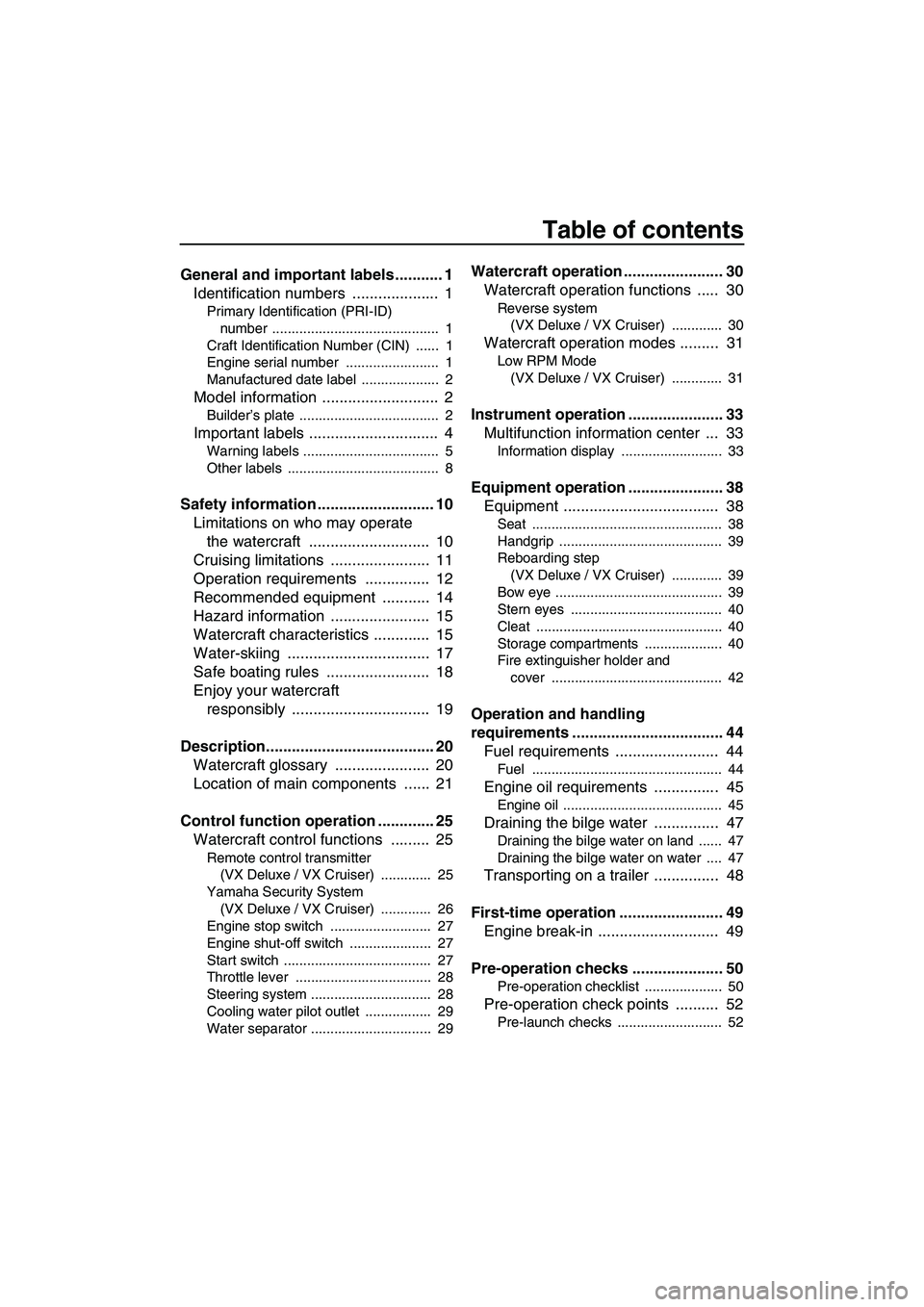
Table of contents
General and important labels ........... 1Identification numbers .................... 1
Primary Identification (PRI-ID)
number ........................................... 1
Craft Identification Number (CIN) ...... 1
Engine serial number ........................ 1
Manufactured date label .................... 2
Model information ........................... 2
Builder’s plate .................................... 2
Important labels .............................. 4
Warning labels ................................... 5
Other labels ....................................... 8
Safety information ........................... 10 Limitations on who may operate the watercraft ............................ 10
Cruising limitations ....................... 11
Operation requirements ............... 12
Recommended equipment ........... 14
Hazard information ....................... 15
Watercraft characteristics ............. 15
Water-skiing ................................. 17
Safe boating rules ........................ 18
Enjoy your watercraft responsibly ................................ 19
Description....................................... 20 Watercraft glossary ...................... 20
Location of main components ...... 21
Control function operation ............. 25 Watercraft control functions ......... 25
Remote control transmitter
(VX Deluxe / VX Cruiser) ............. 25
Yamaha Security System (VX Deluxe / VX Cruiser) ............. 26
Engine stop switch .......................... 27
Engine shut-off switch ..................... 27
Start switch ...................................... 27
Throttle lever ................................... 28
Steering system ............................... 28
Cooling water pilot outlet ................. 29
Water separator ............................... 29
Watercraft operation ....................... 30 Watercraft operation functions ..... 30
Reverse system
(VX Deluxe / VX Cruiser) ............. 30
Watercraft operation modes ......... 31
Low RPM Mode
(VX Deluxe / VX Cruiser) ............. 31
Instrument operation ...................... 33Multifunction information center ... 33
Information display .......................... 33
Equipment operation ...................... 38Equipment .................................... 38
Seat ................................................. 38
Handgrip .......................................... 39
Reboarding step
(VX Deluxe / VX Cruiser) ............. 39
Bow eye ........................................... 39
Stern eyes ....................................... 40
Cleat ................................................ 40
Storage compartments .................... 40
Fire extinguisher holder and cover ............................................ 42
Operation and handling
requirements ................................... 44Fuel requirements ........................ 44
Fuel ................................................. 44
Engine oil requirements ............... 45
Engine oil ......................................... 45
Draining the bilge water ............... 47
Draining the bilge water on land ...... 47
Draining the bilge water on water .... 47
Transporting on a trailer ............... 48
First-time operation ........................ 49 Engine break-in ............................ 49
Pre-operation checks ..................... 50
Pre-operation checklist .................... 50
Pre-operation check points .......... 52
Pre-launch checks ........................... 52
UF2P70E0.book Page 1 Tuesday, July 31, 2012 1:48 PM
Page 9 of 96
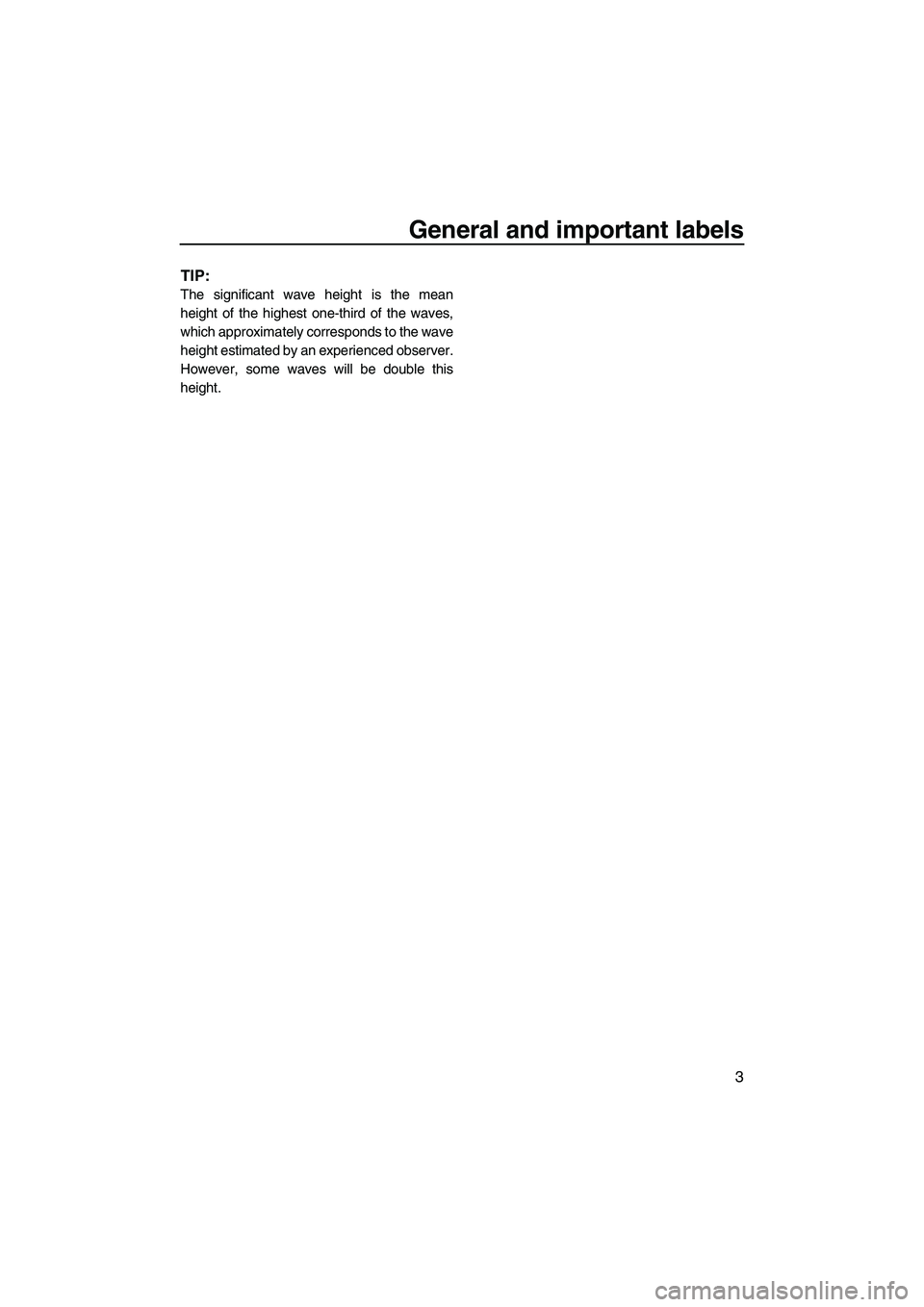
General and important labels
3
TIP:
The significant wave height is the mean
height of the highest one-third of the waves,
which approximately corresponds to the wave
height estimated by an experienced observer.
However, some waves will be double this
height.
UF2P70E0.book Page 3 Tuesday, July 31, 2012 1:48 PM
Page 20 of 96
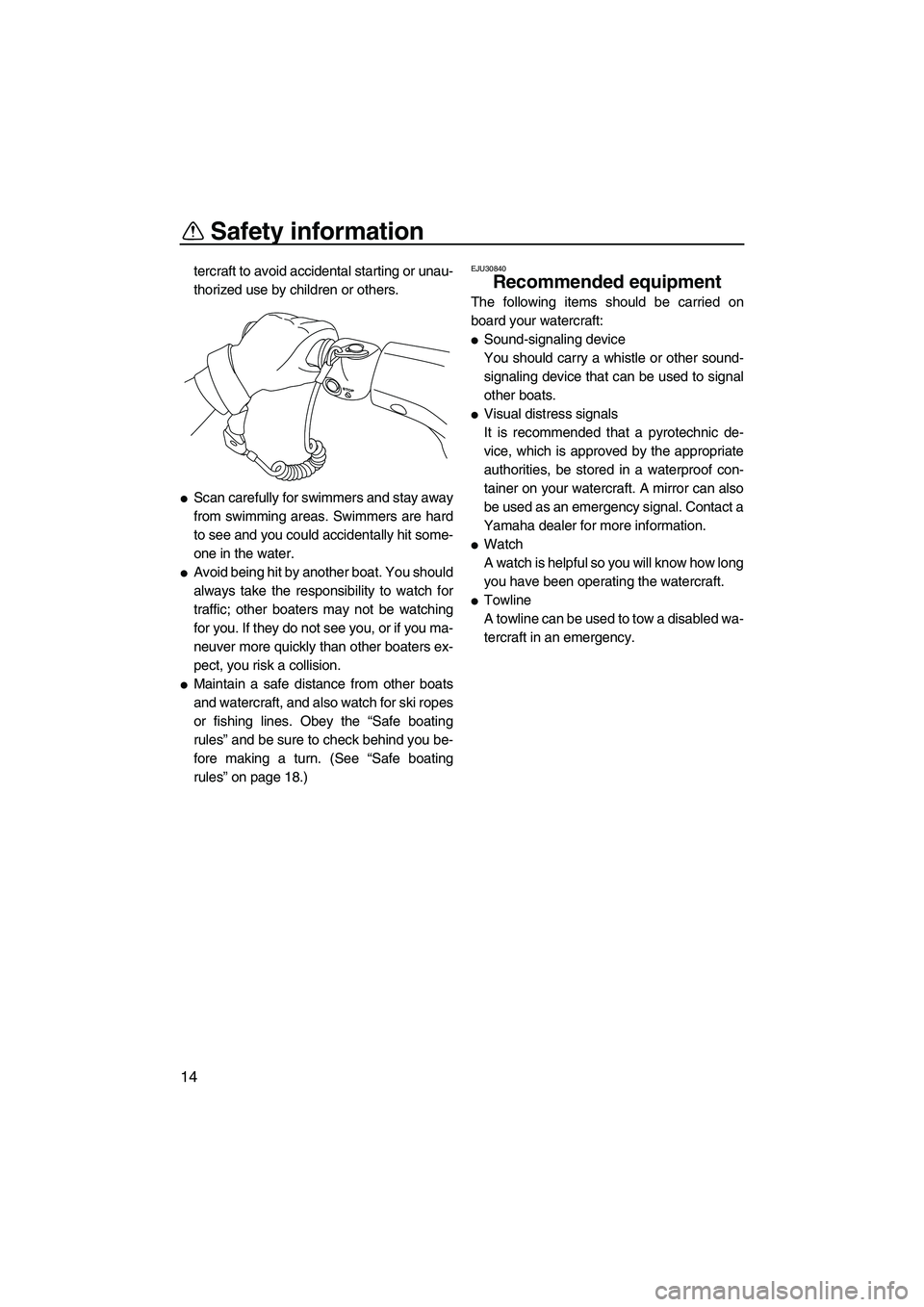
Safety information
14
tercraft to avoid accidental starting or unau-
thorized use by children or others.
●Scan carefully for swimmers and stay away
from swimming areas. Swimmers are hard
to see and you could accidentally hit some-
one in the water.
●Avoid being hit by another boat. You should
always take the responsibility to watch for
traffic; other boaters may not be watching
for you. If they do not see you, or if you ma-
neuver more quickly than other boaters ex-
pect, you risk a collision.
●Maintain a safe distance from other boats
and watercraft, and also watch for ski ropes
or fishing lines. Obey the “Safe boating
rules” and be sure to check behind you be-
fore making a turn. (See “Safe boating
rules” on page 18.)
EJU30840
Recommended equipment
The following items should be carried on
board your watercraft:
●Sound-signaling device
You should carry a whistle or other sound-
signaling device that can be used to signal
other boats.
●Visual distress signals
It is recommended that a pyrotechnic de-
vice, which is approved by the appropriate
authorities, be stored in a waterproof con-
tainer on your watercraft. A mirror can also
be used as an emergency signal. Contact a
Yamaha dealer for more information.
●Watch
A watch is helpful so you will know how long
you have been operating the watercraft.
●Towline
A towline can be used to tow a disabled wa-
tercraft in an emergency.
UF2P70E0.book Page 14 Tuesday, July 31, 2012 1:48 PM
Page 21 of 96
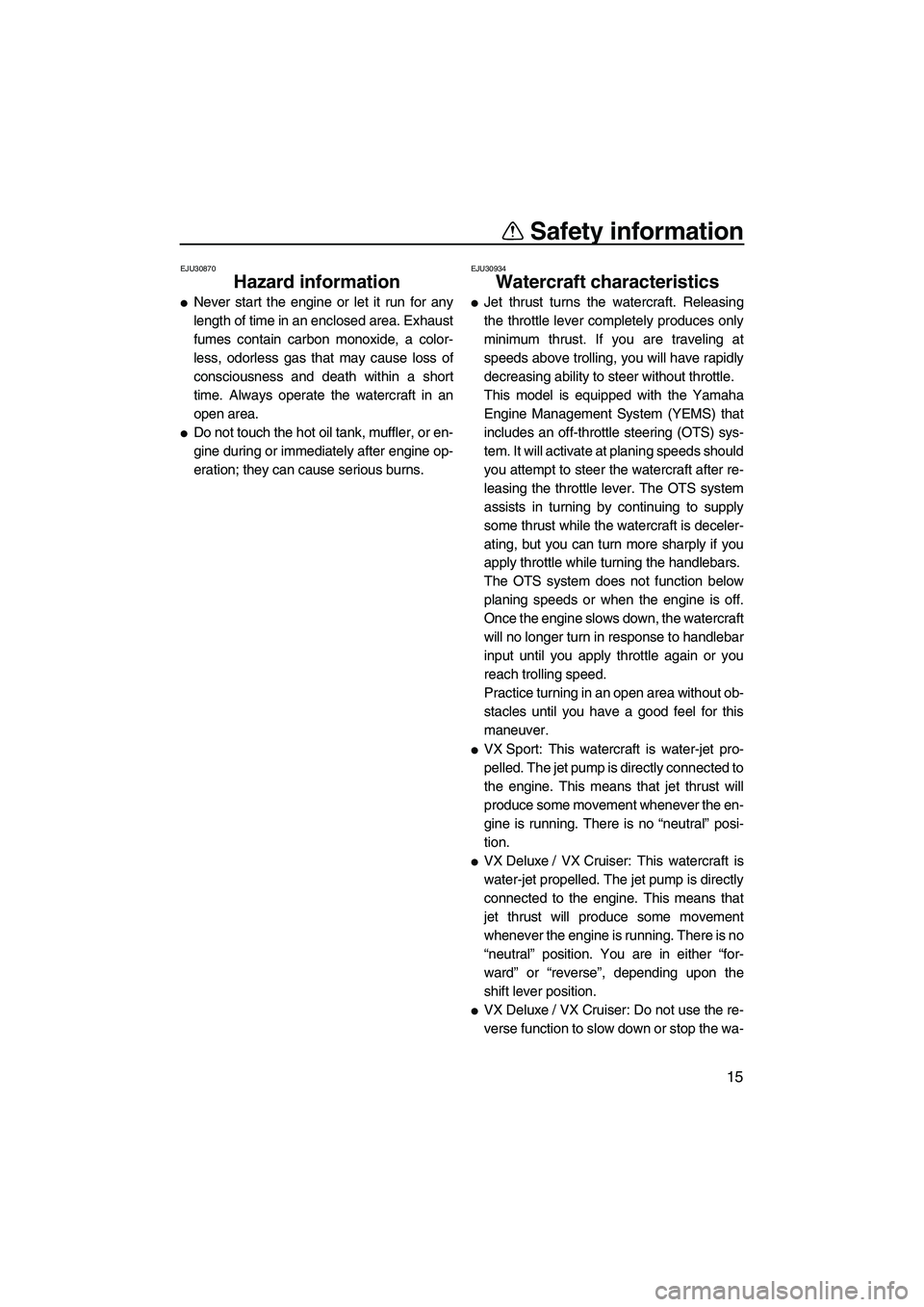
Safety information
15
EJU30870
Hazard information
●Never start the engine or let it run for any
length of time in an enclosed area. Exhaust
fumes contain carbon monoxide, a color-
less, odorless gas that may cause loss of
consciousness and death within a short
time. Always operate the watercraft in an
open area.
●Do not touch the hot oil tank, muffler, or en-
gine during or immediately after engine op-
eration; they can cause serious burns.
EJU30934
Watercraft characteristics
●Jet thrust turns the watercraft. Releasing
the throttle lever completely produces only
minimum thrust. If you are traveling at
speeds above trolling, you will have rapidly
decreasing ability to steer without throttle.
This model is equipped with the Yamaha
Engine Management System (YEMS) that
includes an off-throttle steering (OTS) sys-
tem. It will activate at planing speeds should
you attempt to steer the watercraft after re-
leasing the throttle lever. The OTS system
assists in turning by continuing to supply
some thrust while the watercraft is deceler-
ating, but you can turn more sharply if you
apply throttle while turning the handlebars.
The OTS system does not function below
planing speeds or when the engine is off.
Once the engine slows down, the watercraft
will no longer turn in response to handlebar
input until you apply throttle again or you
reach trolling speed.
Practice turning in an open area without ob-
stacles until you have a good feel for this
maneuver.
●VX Sport: This watercraft is water-jet pro-
pelled. The jet pump is directly connected to
the engine. This means that jet thrust will
produce some movement whenever the en-
gine is running. There is no “neutral” posi-
tion.
●VX Deluxe / VX Cruiser: This watercraft is
water-jet propelled. The jet pump is directly
connected to the engine. This means that
jet thrust will produce some movement
whenever the engine is running. There is no
“neutral” position. You are in either “for-
ward” or “reverse”, depending upon the
shift lever position.
●VX Deluxe / VX Cruiser: Do not use the re-
verse function to slow down or stop the wa-
UF2P70E0.book Page 15 Tuesday, July 31, 2012 1:48 PM
Page 23 of 96
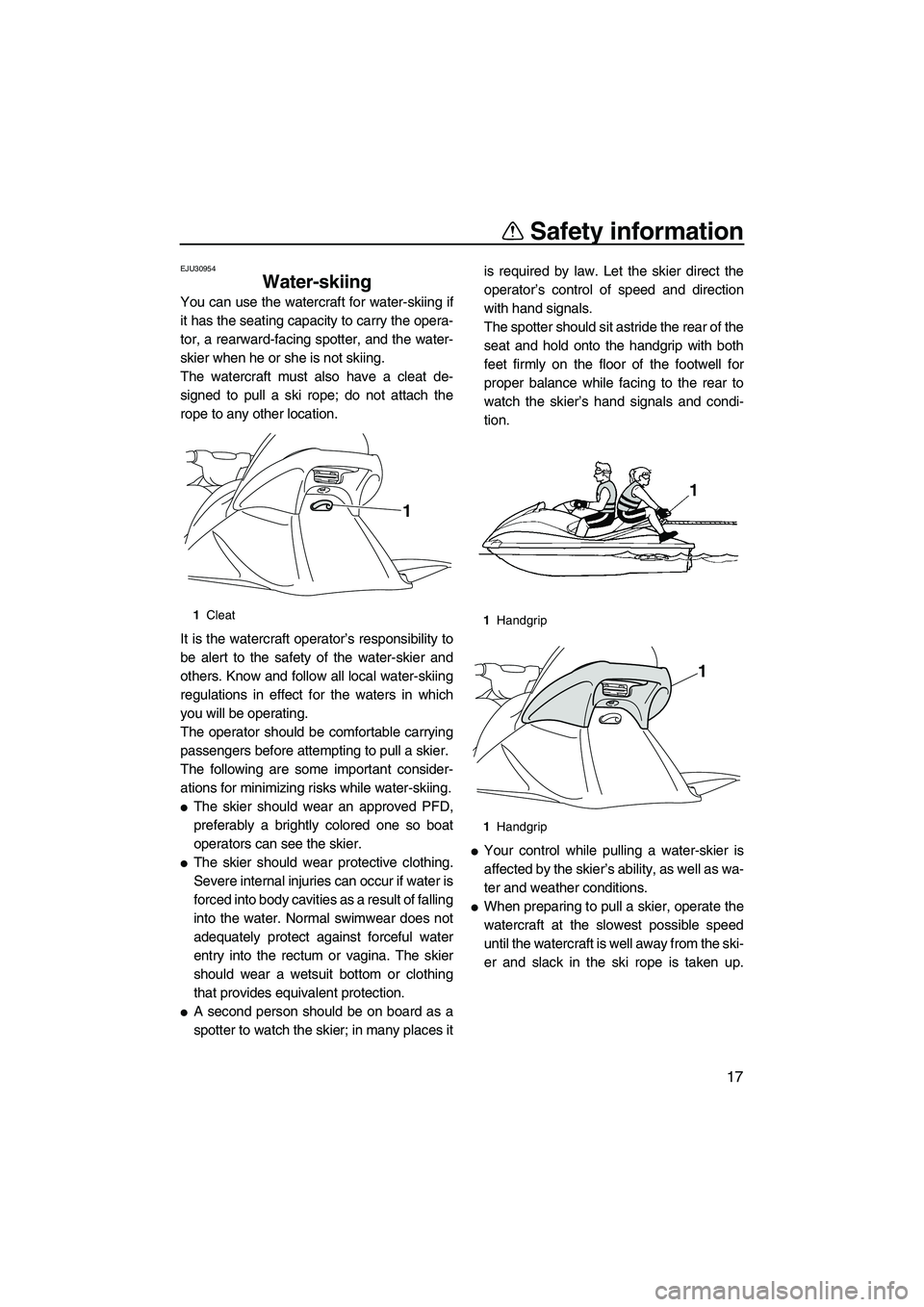
Safety information
17
EJU30954
Water-skiing
You can use the watercraft for water-skiing if
it has the seating capacity to carry the opera-
tor, a rearward-facing spotter, and the water-
skier when he or she is not skiing.
The watercraft must also have a cleat de-
signed to pull a ski rope; do not attach the
rope to any other location.
It is the watercraft operator’s responsibility to
be alert to the safety of the water-skier and
others. Know and follow all local water-skiing
regulations in effect for the waters in which
you will be operating.
The operator should be comfortable carrying
passengers before attempting to pull a skier.
The following are some important consider-
ations for minimizing risks while water-skiing.
●The skier should wear an approved PFD,
preferably a brightly colored one so boat
operators can see the skier.
●The skier should wear protective clothing.
Severe internal injuries can occur if water is
forced into body cavities as a result of falling
into the water. Normal swimwear does not
adequately protect against forceful water
entry into the rectum or vagina. The skier
should wear a wetsuit bottom or clothing
that provides equivalent protection.
●A second person should be on board as a
spotter to watch the skier; in many places itis required by law. Let the skier direct the
operator’s control of speed and direction
with hand signals.
The spotter should sit astride the rear of the
seat and hold onto the handgrip with both
feet firmly on the floor of the footwell for
proper balance while facing to the rear to
watch the skier’s hand signals and condi-
tion.
●Your control while pulling a water-skier is
affected by the skier’s ability, as well as wa-
ter and weather conditions.
●When preparing to pull a skier, operate the
watercraft at the slowest possible speed
until the watercraft is well away from the ski-
er and slack in the ski rope is taken up.
1
Cleat
1
1Handgrip
1 Handgrip
1
UF2P70E0.book Page 17 Tuesday, July 31, 2012 1:48 PM
Page 25 of 96
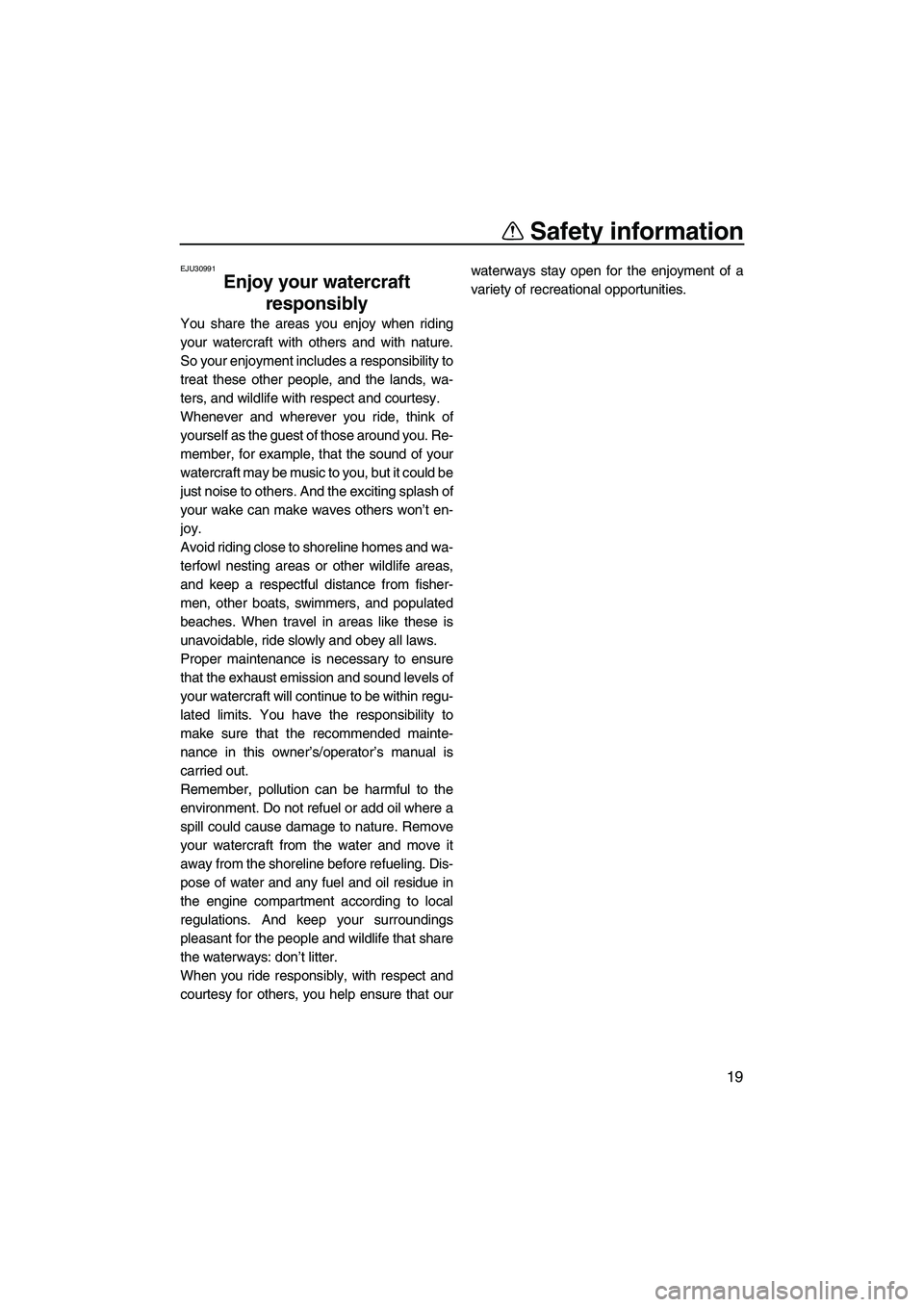
Safety information
19
EJU30991
Enjoy your watercraft responsibly
You share the areas you enjoy when riding
your watercraft with others and with nature.
So your enjoyment includes a responsibility to
treat these other people, and the lands, wa-
ters, and wildlife with respect and courtesy.
Whenever and wherever you ride, think of
yourself as the guest of those around you. Re-
member, for example, that the sound of your
watercraft may be music to you, but it could be
just noise to others. And the exciting splash of
your wake can make waves others won’t en-
joy.
Avoid riding close to shoreline homes and wa-
terfowl nesting areas or other wildlife areas,
and keep a respectful distance from fisher-
men, other boats, swimmers, and populated
beaches. When travel in areas like these is
unavoidable, ride slowly and obey all laws.
Proper maintenance is necessary to ensure
that the exhaust emission and sound levels of
your watercraft will continue to be within regu-
lated limits. You have the responsibility to
make sure that the recommended mainte-
nance in this owner’s/operator’s manual is
carried out.
Remember, pollution can be harmful to the
environment. Do not refuel or add oil where a
spill could cause damage to nature. Remove
your watercraft from the water and move it
away from the shoreline before refueling. Dis-
pose of water and any fuel and oil residue in
the engine compartment according to local
regulations. And keep your surroundings
pleasant for the people and wildlife that share
the waterways: don’t litter.
When you ride responsibly, with respect and
courtesy for others, you help ensure that our waterways stay open for the enjoyment of a
variety of recreational opportunities.
UF2P70E0.book Page 19 Tuesday, July 31, 2012 1:48 PM
Page 35 of 96
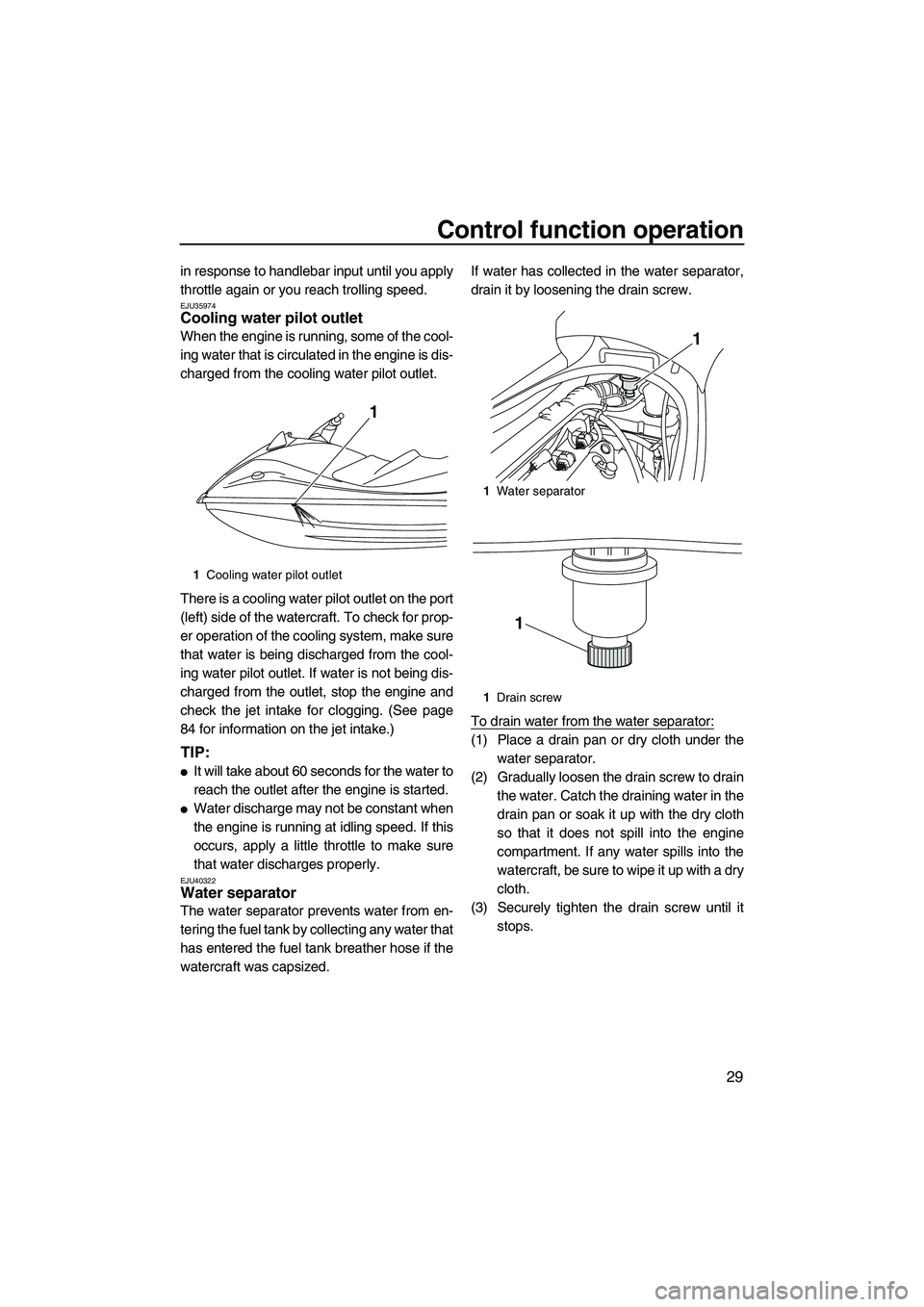
Control function operation
29
in response to handlebar input until you apply
throttle again or you reach trolling speed.
EJU35974Cooling water pilot outlet
When the engine is running, some of the cool-
ing water that is circulated in the engine is dis-
charged from the cooling water pilot outlet.
There is a cooling water pilot outlet on the port
(left) side of the watercraft. To check for prop-
er operation of the cooling system, make sure
that water is being discharged from the cool-
ing water pilot outlet. If water is not being dis-
charged from the outlet, stop the engine and
check the jet intake for clogging. (See page
84 for information on the jet intake.)
TIP:
●It will take about 60 seconds for the water to
reach the outlet after the engine is started.
●Water discharge may not be constant when
the engine is running at idling speed. If this
occurs, apply a little throttle to make sure
that water discharges properly.
EJU40322Water separator
The water separator prevents water from en-
tering the fuel tank by collecting any water that
has entered the fuel tank breather hose if the
watercraft was capsized.If water has collected in the water separator,
drain it by loosening the drain screw.
To drain water from the water separator:
(1) Place a drain pan or dry cloth under the
water separator.
(2) Gradually loosen the drain screw to drain the water. Catch the draining water in the
drain pan or soak it up with the dry cloth
so that it does not spill into the engine
compartment. If any water spills into the
watercraft, be sure to wipe it up with a dry
cloth.
(3) Securely tighten the drain screw until it stops.
1Cooling water pilot outlet
1
1Water separator
1 Drain screw
1
1
UF2P70E0.book Page 29 Tuesday, July 31, 2012 1:48 PM
Page 69 of 96
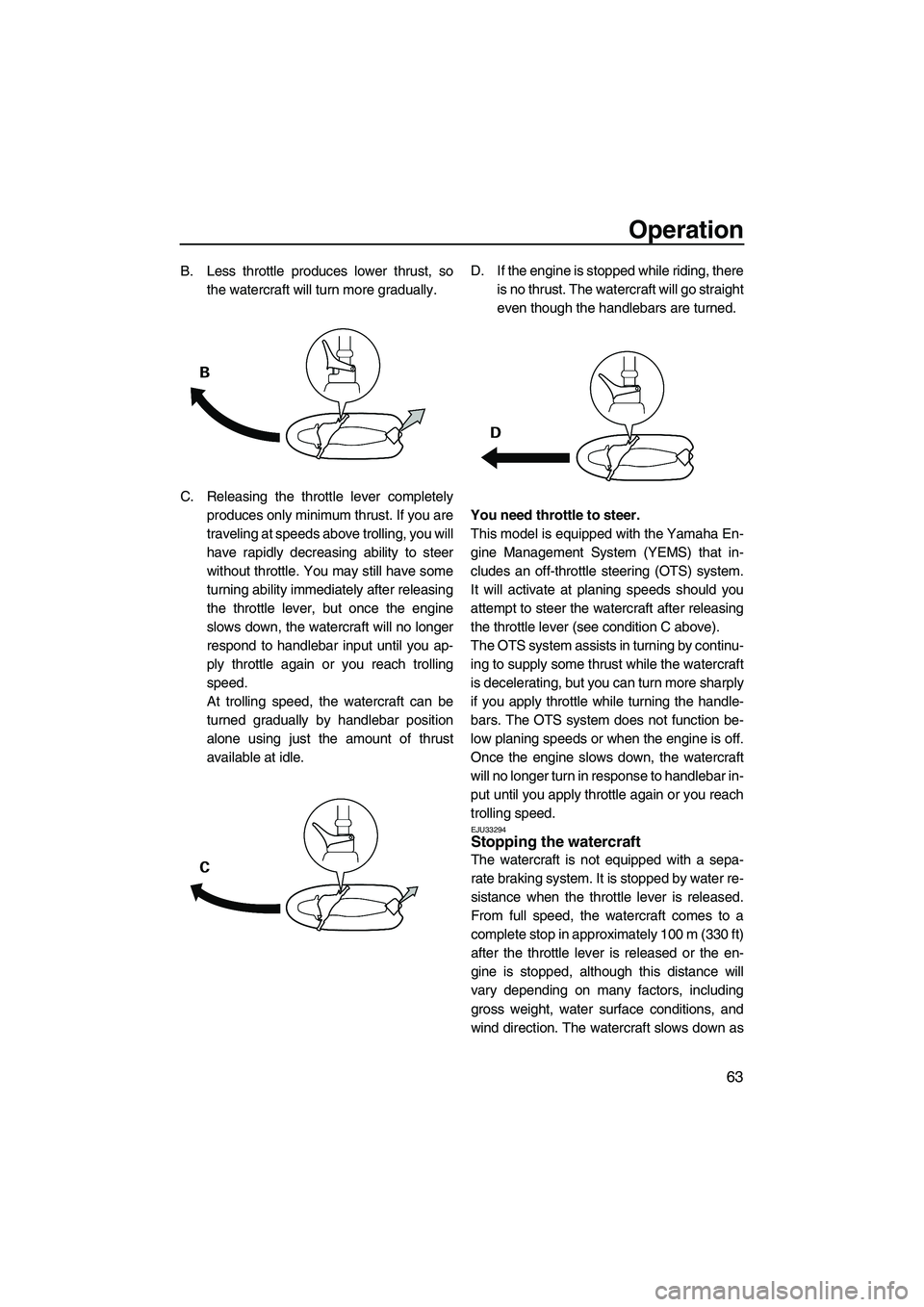
Operation
63
B. Less throttle produces lower thrust, sothe watercraft will turn more gradually.
C. Releasing the throttle lever completely produces only minimum thrust. If you are
traveling at speeds above trolling, you will
have rapidly decreasing ability to steer
without throttle. You may still have some
turning ability immediately after releasing
the throttle lever, but once the engine
slows down, the watercraft will no longer
respond to handlebar input until you ap-
ply throttle again or you reach trolling
speed.
At trolling speed, the watercraft can be
turned gradually by handlebar position
alone using just the amount of thrust
available at idle. D. If the engine is stopped while riding, there
is no thrust. The watercraft will go straight
even though the handlebars are turned.
You need throttle to steer.
This model is equipped with the Yamaha En-
gine Management System (YEMS) that in-
cludes an off-throttle steering (OTS) system.
It will activate at planing speeds should you
attempt to steer the watercraft after releasing
the throttle lever (see condition C above).
The OTS system assists in turning by continu-
ing to supply some thrust while the watercraft
is decelerating, but you can turn more sharply
if you apply throttle while turning the handle-
bars. The OTS system does not function be-
low planing speeds or when the engine is off.
Once the engine slows down, the watercraft
will no longer turn in response to handlebar in-
put until you apply throttle again or you reach
trolling speed.
EJU33294Stopping the watercraft
The watercraft is not equipped with a sepa-
rate braking system. It is stopped by water re-
sistance when the throttle lever is released.
From full speed, the watercraft comes to a
complete stop in approximately 100 m (330 ft)
after the throttle lever is released or the en-
gine is stopped, although this distance will
vary depending on many factors, including
gross weight, water surface conditions, and
wind direction. The watercraft slows down as
UF2P70E0.book Page 63 Tuesday, July 31, 2012 1:48 PM
Page 76 of 96
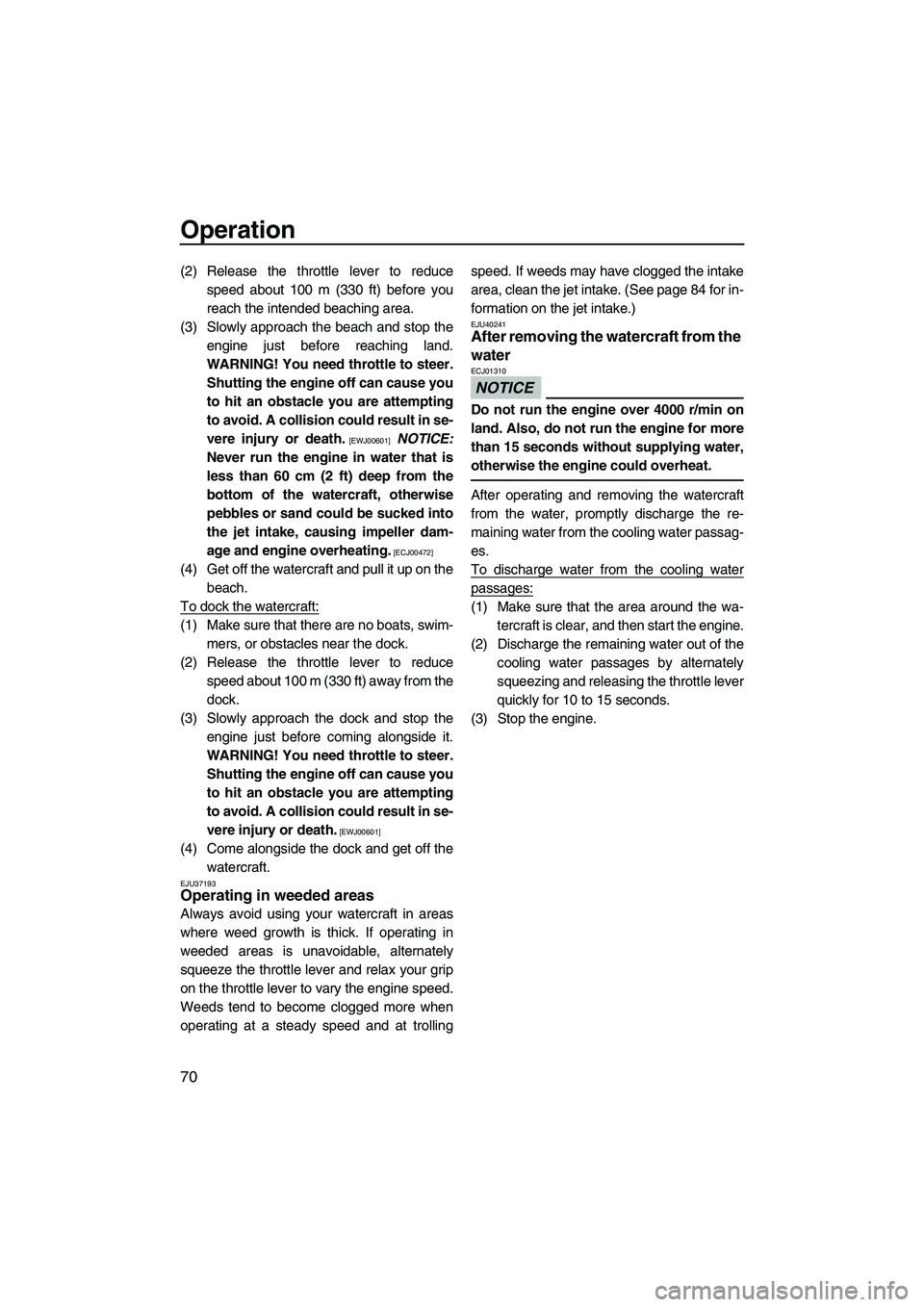
Operation
70
(2) Release the throttle lever to reducespeed about 100 m (330 ft) before you
reach the intended beaching area.
(3) Slowly approach the beach and stop the engine just before reaching land.
WARNING! You need throttle to steer. Shutting the engine off can cause you
to hit an obstacle you are attempting
to avoid. A collision could result in se-
vere injury or death.
[EWJ00601] NOTICE:
Never run the engine in water that is
less than 60 cm (2 ft) deep from the
bottom of the watercraft, otherwise
pebbles or sand could be sucked into
the jet intake, causing impeller dam-
age and engine overheating.
[ECJ00472]
(4) Get off the watercraft and pull it up on the beach.
To dock the watercraft:
(1) Make sure that there are no boats, swim- mers, or obstacles near the dock.
(2) Release the throttle lever to reduce speed about 100 m (330 ft) away from the
dock.
(3) Slowly approach the dock and stop the engine just before coming alongside it.
WARNING! You need throttle to steer. Shutting the engine off can cause you
to hit an obstacle you are attempting
to avoid. A collision could result in se-
vere injury or death.
[EWJ00601]
(4) Come alongside the dock and get off the watercraft.
EJU37193Operating in weeded areas
Always avoid using your watercraft in areas
where weed growth is thick. If operating in
weeded areas is unavoidable, alternately
squeeze the throttle lever and relax your grip
on the throttle lever to vary the engine speed.
Weeds tend to become clogged more when
operating at a steady speed and at trolling speed. If weeds may have clogged the intake
area, clean the jet intake. (See page 84 for in-
formation on the jet intake.)
EJU40241After removing the watercraft from the
water
NOTICE
ECJ01310
Do not run the engine over 4000 r/min on
land. Also, do not run the engine for more
than 15 seconds without supplying water,
otherwise the engine could overheat.
After operating and removing the watercraft
from the water, promptly discharge the re-
maining water from the cooling water passag-
es.
To discharge water from the cooling water
passages:
(1) Make sure that the area around the wa-
tercraft is clear, and then start the engine.
(2) Discharge the remaining water out of the cooling water passages by alternately
squeezing and releasing the throttle lever
quickly for 10 to 15 seconds.
(3) Stop the engine.
UF2P70E0.book Page 70 Tuesday, July 31, 2012 1:48 PM